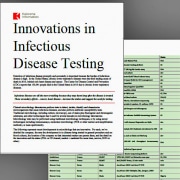What Does The “Second Wave” of 2018/19 Flu Season Mean for IVD Markets?
The CDC reports a late peak and possible second wave to what was previously thought to be a weaker flu season compared to recent years. This is important for IVD makers, as respiratory IVD markets are driven to a great extent by the severity of the flu season. While the total number of cases remains below 30M, and thus less than last year, recent weeks saw a small peak and there’s a new strain that is demonstrating virulence.
The CDC reports a late peak and possible second wave to what was previously thought to be a weaker flu season compared to recent years. This is important for IVD makers, as respiratory IVD markets are driven to a great extent by the severity of the flu season. The chart accompanying depicts the flu cases in thousands for the weeks of 2019. instead of fully declining, there was a late peak in February. While the total number of cases remains below 30M, and thus less than last year, recent weeks saw a small peak and there’s a new strain that is demonstrating virulence.
Per the CDC: Since October 1, there have been nearly 26.3 million cases of the flu, as many as 12.4 million flu-related medical visits, and up to 31,200 deaths caused by the flu. Nine children died from the flu last week, bringing the total of pediatric deaths this season to 64. There are two main groups of influenza viruses: influenza A and influenza B.
Respiratory systems such as those that detect flu are a key component of the true molecular point of care market, representing decentralized rapid or CLIA waived systesm. And revenues for respiratory represents nearly sixty percent of this market according to the Market and Potential for Molecular Point of Care Diagnostic Tests 2019
https://kaloramainformation.com/product/the-market-and-potential-for-molecular-point-of-care-diagnostic-tests-2019/
According to that report, the flu season’s severity in 2017/18 created an opportunity for new systems. This year, a new strain is concerning. The H3N2 strain belongs to the influenza A family. In addition to the typical symptoms of flu, which include fevers, chills, body aches, and rigors [shaking chills], it additionally has the potential of causing several severe complications, including very high fevers.
CDC estimates that the burden of illness during the 2017–2018 season was also high with an estimated 48.8 million people getting sick with influenza, 22.7 million people going to a health care provider, 959,000 hospitalizations, and 79,400 deaths from influenza (Table 1). The number of cases of influenza-associated illness that occurred last season was the highest since the 2009 H1N1 pandemic, when an estimated 60 million people were sick with influenza6.
While this flu season has not been quite as severe as seasons past, there has been a recent uptick in a less common flu strain, the H3N2 virus, now accounting for over 50 percent of new cases, according to recent data from the CDC. There have been 350,000 hospitalizations according to the agency.
Since near patient-testing systems using PCR technology first appeared on the market, the leading IVD market research publisher Kalorama Information has provided sound market estimates and forecasts for their usage. As these systems move from novel to closer to a routine usage, our 2019 update provides essential information for marketers in IVD.
Kalorama’s report is a true look at the clinical market for molecular systems, both CLIA-waived and those CLIA-moderate that can be used in an office visit. The report incorporates systems in development as of 2019 and updates on competitor laggards in previous editions that have not produced products.
Companies in the molecular point-of-care market include: Abbott, Roche, Biomerieux BioFire and Danaher’s Cepheid, among others.





